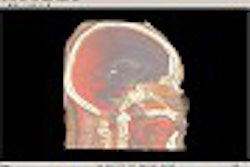SAN FRANCISCO - Despite a wide range of numbers seen in the medical literature, a multidisciplinary committee of nearly 25 experts arrived at a surprisingly easy consensus last week on ultrasound thresholds for diagnosing stenosis of the internal carotid artery.
The numbers agreed upon in an effort organized by the Society of Radiologists in Ultrasound were announced Friday by Dr. Edward Grant, chairman of the radiology department at the University of Southern California’s Keck School of Medicine in Los Angeles. Attendees at the SRU’s annual meeting in San Francisco received a detailed and lively report on the findings from Grant, who had chaired the consensus conference earlier in the week.
"If you look at some of these people (on the consensus committee), many of them really are the folks who have been the movers and shakers in carotid ultrasound," Grant said. "The fact that we assembled this group of people, locked them all in the same room for two days and actually came to some conclusions, was fairly miraculous."
The consensus committee, which included radiologists, vascular surgeons, neurologists, and other experts, determined that a peak systolic velocity of 125 cm per second or less at the origin of the internal carotid artery was indicative of either normal or less than 50% stenosis. An ICA PSV of 125-230 cm per second would indicate 50%-69% stenosis, and greater than 230 cm per second would indicate 70% or greater stenosis -- the threshold for sending a patient for carotid endarterectomy surgery at most facilities.
The group also favored the use of the systolic ratio and end diastolic velocity as secondary diagnostic parameters (see chart). "There are lots of folks out there who believe the end diastolic velocity is particularly helpful in differentiating high-grade from mid-range lesions," Grant noted. "Also, the systolic ratio will also help you to use the patient as their own internal control."
|
ICA PSV |
Plaque |
ICA/CCA PSV ratio |
ICA EDV |
|
|
Normal |
<125 cm/s |
None |
<2.0 |
<40 cm/s |
|
<50% |
<125 cm/s |
<50% diameter reduction |
<2.0 |
<40 cm/s |
|
50-69% |
125-230 cm/s |
>/= 50% diameter reduction |
2.0-4.0 |
40-100 cm/s |
|
>/=70% to near occlusion |
>230 cm/s |
>/= 50% diameter reduction |
>4.0 |
>100 cm/s |
|
Near occlusion |
May be low or undetectable |
Visible |
Variable |
Variable |
|
Total occlusion |
Undetectable |
Visible, no detectable lumen |
Not applicable |
Not applicable |
Grant noted that the consensus was particularly impressive given the disparate numbers previously cited by members of the committee. For example, thresholds cited as indicative of 70% stenosis ranged from an ICA PSV of 325 cm/s published by committee member and vascular surgeon Gregory Moneta, down to the 175 cm/s published by Grant and co-authors.
But while the committee views its consensus numbers as widely applicable -- despite anticipated variation due to differing equipment and other factors -- Grant also cautioned that the consensus thresholds weren’t intended as gospel. "Doppler is not an exact science," Grant said. "This is not for somebody who has an established lab with internally validated numbers."
Nonetheless, considering the wide range of numbers in the literature, and the fact that many labs were following older published studies in which the thresholds weren’t correlated with the North American Symptomatic Carotid Endarterectomy Trial (NASCET) study’s angiographic gold standard, the planned publication of the SRU’s consensus findings could prove influential. And that could have surgical implications for many patients with atherosclerosis of the internal carotid artery, since, as Grant noted, carotid ultrasound "is no longer an adjunctive exam in many labs."
By Tracie L. Thompson
AuntMinnie.com contributing writer
October 28, 2002
Related Reading
Conferees seek consensus on carotid ultrasound, October 23, 2002
Quick ultrasound screening for AAA recommended in older men, September 27, 2002
New techniques increase ultrasound’s value in vascular imaging, July 8, 2002
B-flow ultrasound shows promise in carotid artery imaging, April 4, 2002
Copyright © 2002 AuntMinnie.com


















